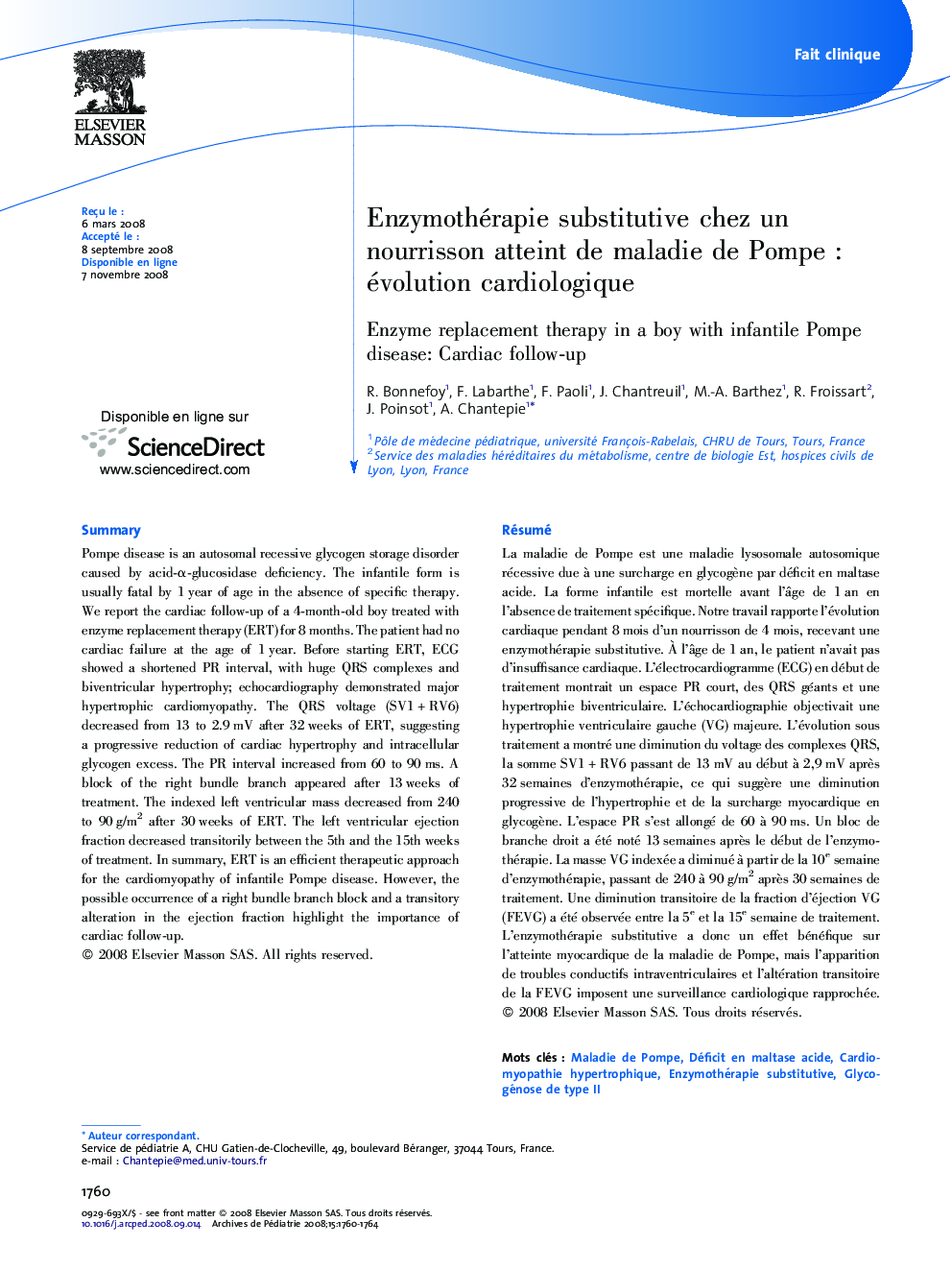| کد مقاله | کد نشریه | سال انتشار | مقاله انگلیسی | نسخه تمام متن |
|---|---|---|---|---|
| 4149183 | 1272730 | 2008 | 5 صفحه PDF | دانلود رایگان |

RésuméLa maladie de Pompe est une maladie lysosomale autosomique récessive due à une surcharge en glycogène par déficit en maltase acide. La forme infantile est mortelle avant l’âge de 1 an en l’absence de traitement spécifique. Notre travail rapporte l’évolution cardiaque pendant 8 mois d’un nourrisson de 4 mois, recevant une enzymothérapie substitutive. À l’âge de 1 an, le patient n’avait pas d’insuffisance cardiaque. L’électrocardiogramme (ECG) en début de traitement montrait un espace PR court, des QRS géants et une hypertrophie biventriculaire. L’échocardiographie objectivait une hypertrophie ventriculaire gauche (VG) majeure. L’évolution sous traitement a montré une diminution du voltage des complexes QRS, la somme SV1 + RV6 passant de 13 mV au début à 2,9 mV après 32 semaines d’enzymothérapie, ce qui suggère une diminution progressive de l’hypertrophie et de la surcharge myocardique en glycogène. L’espace PR s’est allongé de 60 à 90 ms. Un bloc de branche droit a été noté 13 semaines après le début de l’enzymothérapie. La masse VG indexée a diminué à partir de la 10e semaine d’enzymothérapie, passant de 240 à 90 g/m2 après 30 semaines de traitement. Une diminution transitoire de la fraction d’éjection VG (FEVG) a été observée entre la 5e et la 15e semaine de traitement. L’enzymothérapie substitutive a donc un effet bénéfique sur l’atteinte myocardique de la maladie de Pompe, mais l’apparition de troubles conductifs intraventriculaires et l’altération transitoire de la FEVG imposent une surveillance cardiologique rapprochée.
SummaryPompe disease is an autosomal recessive glycogen storage disorder caused by acid-α-glucosidase deficiency. The infantile form is usually fatal by 1 year of age in the absence of specific therapy. We report the cardiac follow-up of a 4-month-old boy treated with enzyme replacement therapy (ERT) for 8 months. The patient had no cardiac failure at the age of 1 year. Before starting ERT, ECG showed a shortened PR interval, with huge QRS complexes and biventricular hypertrophy; echocardiography demonstrated major hypertrophic cardiomyopathy. The QRS voltage (SV1 + RV6) decreased from 13 to 2.9 mV after 32 weeks of ERT, suggesting a progressive reduction of cardiac hypertrophy and intracellular glycogen excess. The PR interval increased from 60 to 90 ms. A block of the right bundle branch appeared after 13 weeks of treatment. The indexed left ventricular mass decreased from 240 to 90 g/m2 after 30 weeks of ERT. The left ventricular ejection fraction decreased transitorily between the 5th and the 15th weeks of treatment. In summary, ERT is an efficient therapeutic approach for the cardiomyopathy of infantile Pompe disease. However, the possible occurrence of a right bundle branch block and a transitory alteration in the ejection fraction highlight the importance of cardiac follow-up.
Journal: Archives de Pédiatrie - Volume 15, Issue 12, December 2008, Pages 1760–1764